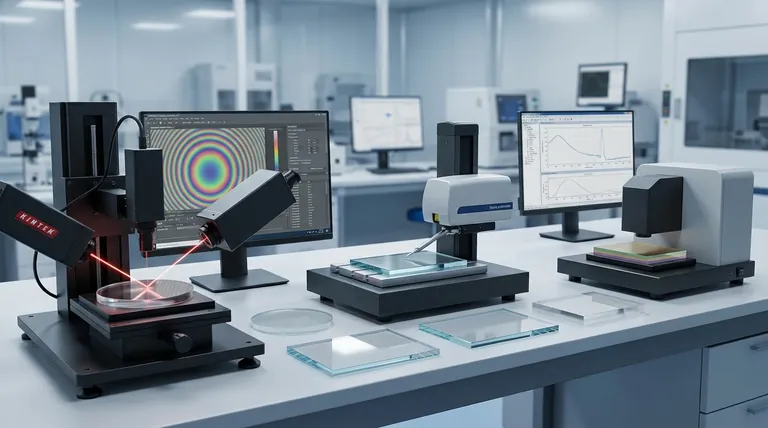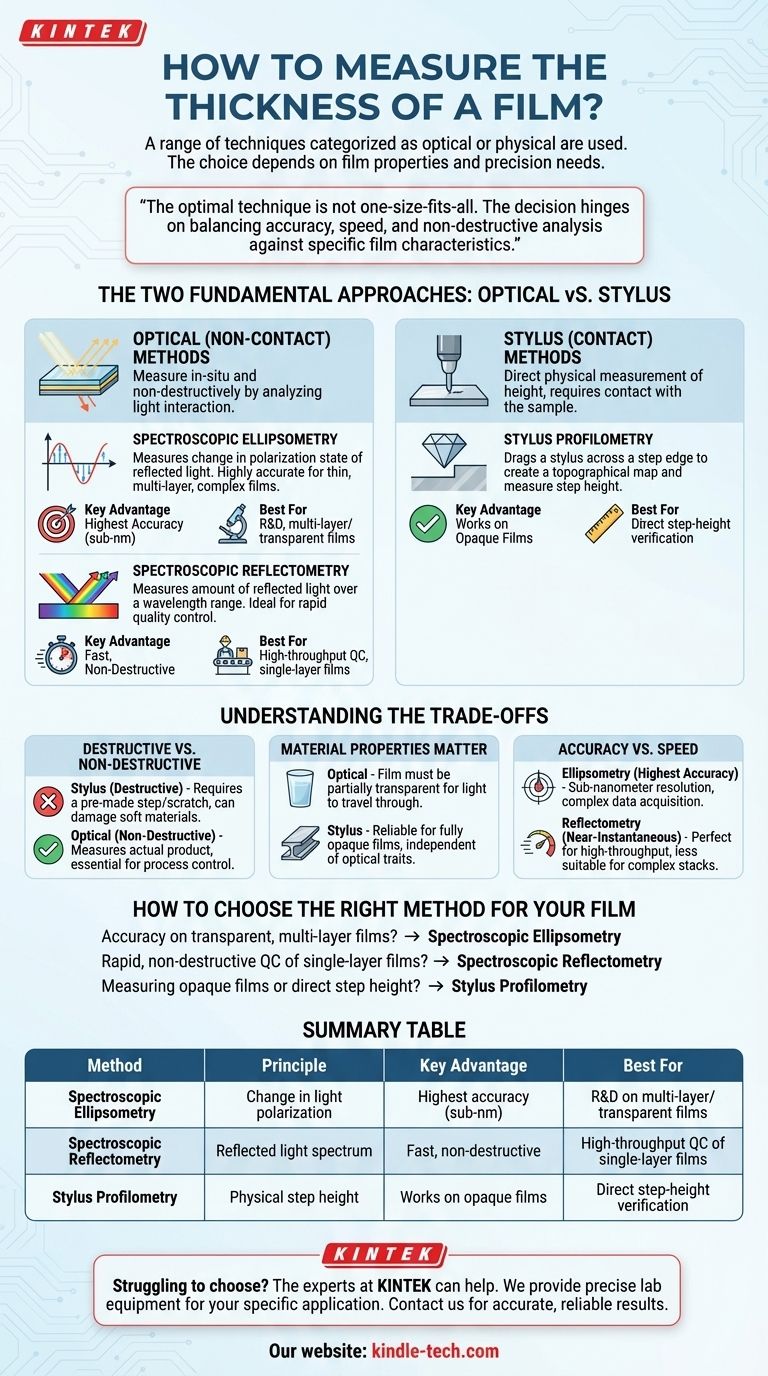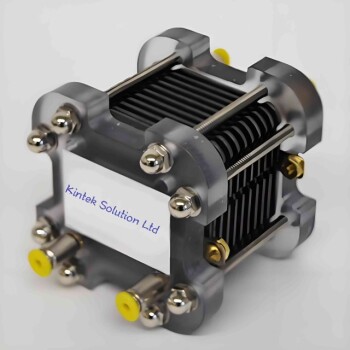Measuring the thickness of a film is accomplished using a range of techniques, broadly categorized as either optical or physical. Optical methods, like spectroscopic ellipsometry and reflectometry, analyze how light interacts with the film, while physical methods, such as stylus profilometry, make direct contact with the surface to measure a step height. The choice of method depends entirely on the film's material properties and the required precision.
The optimal technique for measuring film thickness is not one-size-fits-all. The decision hinges on balancing the need for accuracy, speed, and non-destructive analysis against the specific characteristics of your film, such as its transparency, roughness, and composition.

The Two Fundamental Approaches: Optical vs. Stylus
The methods for measuring film thickness, which can be mere nanometers thin, are divided by a simple principle: do you touch the surface or not? This distinction separates techniques into two primary families.
Optical (Non-Contact) Methods
Optical techniques are powerful because they measure the film in-situ and non-destructively. They work by directing a beam of light at the film and analyzing the light that reflects from or transmits through it.
By modeling how the light's properties change, one can determine the thickness with remarkable precision. This is essential for applications like semiconductors and optical coatings where the final product cannot be damaged.
Spectroscopic Ellipsometry
This is one of the most accurate and sensitive optical techniques available. It measures the change in the polarization state of light as it reflects off the film's surface.
Because it measures two distinct values (amplitude ratio and phase difference), ellipsometry is extremely powerful for characterizing very thin, multi-layer, or complex films.
Spectroscopic Reflectometry
Reflectometry is a faster and often simpler optical method. It measures the amount of light reflected from a film over a range of wavelengths.
Interference patterns in the reflected light spectrum are analyzed to calculate thickness. This method is ideal for rapid quality control and for thicker, single-layer transparent films.
Stylus (Contact) Methods
Contact methods provide a direct, physical measurement of height. They are conceptually simple but require direct contact with the sample, which can be a significant drawback.
Stylus Profilometry
This technique works by gently dragging a fine diamond-tipped stylus across a step edge from the substrate to the top of the film.
The physical deflection of the stylus is recorded to create a topographical map, from which the step height—and thus film thickness—is measured. It is a direct measurement that does not depend on the film's optical properties.
Understanding the Trade-offs
Choosing a measurement technique requires a clear understanding of its limitations. No single method is perfect for every scenario.
Destructive vs. Non-Destructive
This is often the most critical factor. Stylus profilometry is inherently destructive; it requires a pre-made step or scratch in the film and the stylus can damage soft materials.
Optical methods are completely non-destructive, allowing you to measure the actual product part without altering it, which is essential for manufacturing process control.
Material Properties Matter
Optical methods like ellipsometry and reflectometry rely on the film being at least partially transparent or semi-transparent. Light must be able to travel through the film and reflect off the underlying substrate.
For fully opaque films, such as thick metals, stylus profilometry is often the only reliable option because it does not depend on optical characteristics.
Accuracy vs. Speed
Spectroscopic ellipsometry offers the highest accuracy and can resolve thicknesses down to the sub-nanometer level. However, data acquisition and modeling can be more complex and time-consuming.
Spectroscopic reflectometry provides near-instantaneous results, making it perfect for high-throughput environments like production lines, though it may be less suitable for complex, multi-layer film stacks.
How to Choose the Right Method for Your Film
To make a definitive choice, match the technique's strengths to your primary objective.
- If your primary focus is maximum accuracy on transparent, multi-layer films: Spectroscopic ellipsometry is the gold standard for research and development.
- If your primary focus is rapid, non-destructive quality control of single-layer films: Spectroscopic reflectometry offers the ideal balance of speed and simplicity.
- If your primary focus is measuring opaque films or directly verifying a physical step height: Stylus profilometry provides a reliable, unambiguous measurement.
By aligning the measurement technique with your material and goals, you ensure both accuracy and efficiency in your process.
Summary Table:
| Method | Principle | Key Advantage | Best For |
|---|---|---|---|
| Spectroscopic Ellipsometry | Measures change in light polarization | Highest accuracy (sub-nm) | R&D on multi-layer/transparent films |
| Spectroscopic Reflectometry | Analyzes reflected light spectrum | Fast, non-destructive | High-throughput QC of single-layer films |
| Stylus Profilometry | Physical measurement of a step height | Works on opaque films | Direct step-height verification |
Struggling to choose the right film thickness measurement technique for your lab? The experts at KINTEK can help. We specialize in providing the precise lab equipment—from ellipsometers to profilometers—that your research or quality control process demands. Contact our team today to discuss your specific application and find the perfect solution for accurate, reliable results.
Visual Guide

Related Products
- Optical Ultra-Clear Glass Sheet for Laboratory K9 B270 BK7
- Lab Plastic PVC Calender Stretch Film Casting Machine for Film Testing
- Automatic Lab Cold Isostatic Press CIP Machine Cold Isostatic Pressing
- Customizable PEM Electrolysis Cells for Diverse Research Applications
- Metallographic Specimen Mounting Machine for Laboratory Materials and Analysis
People Also Ask
- What are the applications of radioactive substances? From Medical Imaging to Nuclear Power
- What are the factors that affect the filtration of the solution? Master the Key Variables for Optimal Performance
- What are the limitations of the IR spectroscopy? Understanding Its Boundaries for Accurate Analysis
- What is the temperature range of quartz glass? Master Its Thermal Limits for Demanding Applications
- What is an RVC glassy carbon sheet? A High-Performance Material for Demanding Applications

















